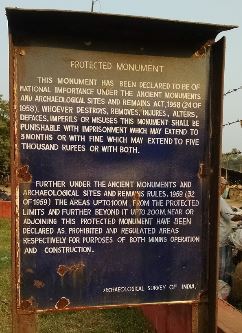 Ever imagined a place called Panduk has a great historicity
to its repertoire? Well yes, the site clocks back to Mesolithic-Chalcolithic
period & was contemporaneous to the late phase of Harappan civilization
(resources can be cross-checked). The site is located at the Ajay valley,
Ausgram II block in East Burdwan district. The name “Pandu Rajar Dhibi” is believed to be associated with the king Pandu of the great epic of Mahabharata and the word “Dhibi” allies as a synonym to what we say mound.
Ever imagined a place called Panduk has a great historicity
to its repertoire? Well yes, the site clocks back to Mesolithic-Chalcolithic
period & was contemporaneous to the late phase of Harappan civilization
(resources can be cross-checked). The site is located at the Ajay valley,
Ausgram II block in East Burdwan district. The name “Pandu Rajar Dhibi” is believed to be associated with the king Pandu of the great epic of Mahabharata and the word “Dhibi” allies as a synonym to what we say mound.
As we explored the area, we noticed several mounds which might be the ones that were excavated in our primitive reasoning. The site came to light when B.B Lal excavated it vertically in 1954-57 (wiki link). Six stratigraphic layers obtained NBPW (Northern Black Polished Ware) that is associated with the emergence of Iron Age in India, Neolithic tools, BRW (Black & Red ware) and Microliths respectively in descending order. A study also advocates to the fact that, the river Ajay once flowed beside Panduk but over a course time changed its path and now flows roughly 16km north-west near Bhedia. The benefits; such as the irrigation, faring to other places and perennial supply of water was regarded exclusively to Ajay but as we know Ajay is a flood-capped river, so an assumption may arise that the sedentary society of Panduk possibly declined or shifted to other alluvium zones due to continuous floods.
Pandu Rajar Dhibi wasn’t a place supporting easy travel in timeline. The context may be linear but it tests the cognizance and observation skills to discern the history out of folklore and true evident facts. Although the site has been excavated partially and proved itself to be immobile from the dawn of prehistoric era to the historic times. More contents await at the site to be dug out.
After spending two hours of quality time there, we moved back to Panduk bus stop and returned to Bolpur. Trains were late and over-crowded as Bolpur-Shantiniketan was garnered with famous Poush-Utsav. But the wait resulted well; a Rampurhat Express was on its way to take us back and that’s how our one day short venture came to an end.






Comments
Post a Comment